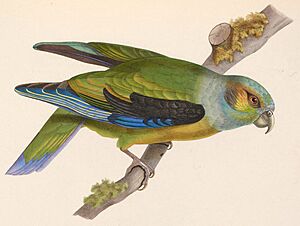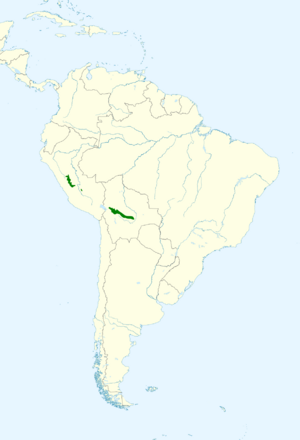Black-winged parrot facts for kids
Quick facts for kids Black-winged parrot |
|
|---|---|
 |
|
| Conservation status | |
| Scientific classification | |
| Genus: |
Hapalopsittaca
|
| Species: |
melanotis
|
 |
|
| Synonyms | |
|
Pionus melanotis de Lafresnaye, 1847 |
|
Meet the black-winged parrot (Hapalopsittaca melanotis), sometimes called the black-eared parrot. This amazing bird is a type of parrot found in the forests of Bolivia and Peru. It belongs to the large parrot family, which includes many colorful birds from Africa and the Americas.
Contents
About the Black-Winged Parrot
What Makes This Parrot Special?
The black-winged parrot is about 24 centimeters (9.4 inches) long. Both male and female parrots look very similar. They are mostly green, with their undersides being a bit more yellowish.
Their head has a blue-gray color on top. Blue feathers are found near their eyes, and pinkish feathers surround their eyes. This gives them a unique and pretty look!
Different Types of Black-Winged Parrots
There are two main types, or subspecies, of the black-winged parrot. One is called H. m. melanotis and the other is H. m. peruviana. These two types have small differences in their appearance.
For example, the H. m. melanotis parrot has black feathers covering its ears. The H. m. peruviana parrot, however, has buff-colored (light yellowish-brown) ear feathers. The H. m. melanotis also has a wider blue-gray band around its neck.
Both types of parrots have mostly black wings. But the main flight feathers on their wings are mostly blue. Their tail feathers are green with blackish-blue tips.
Where Do Black-Winged Parrots Live?
The two types of black-winged parrots live in different areas. They do not share the same exact home. The H. m. melanotis parrot lives in central-west Bolivia. This area includes parts of the La Paz and Santa Cruz regions.
The H. m. peruviana parrot lives in central and southern Peru. You can find them in places like Huánuco, Junín, and Cuzco.
Their Forest Homes
These parrots love to live in humid mountain forests. They can be found in evergreen forests, cloud forests, and even "elfin forests." Elfin forests are dense, tangled forests found at high altitudes.
They live at very high elevations, usually between 1,740 and 3,450 meters (about 5,700 to 11,300 feet) above sea level. They can live in these forests even if the forest patches are small.
Black-Winged Parrot Behavior
How They Move Around
Scientists are still learning about how black-winged parrots move. They might only live at the highest elevations during certain times of the year. It seems they travel around to find food. This means they are nomadic, moving from place to place.
What Do They Eat?
The black-winged parrot's favorite food is berries. They especially love the berries from a type of mistletoe plant called Gaiadendron. Sometimes, groups of up to 50 parrots have been seen flying between different forest areas. They do this to search for the best fruit to eat.
How They Talk
Black-winged parrots have special calls they use when flying. Their flight call sounds like "crrit ... crrit ... crrit .. kie." It's a series of short, soft notes, sometimes followed by a higher, sharper sound.
When they are sitting on a branch, they make many different short, soft calls. When they take off to fly, they might make a faster and longer series of "crrit" notes.
Status of the Black-Winged Parrot
The IUCN (International Union for Conservation of Nature) has looked at the black-winged parrot. They have listed it as a species of "Least Concern." This means they are not currently worried about it becoming endangered.
Even though it lives in a somewhat small area, its population seems to be stable. This means the number of these parrots is not going down. No immediate threats have been found that would harm them. They are common in some places, especially in Bolivia, and can be seen in fairly large groups.


